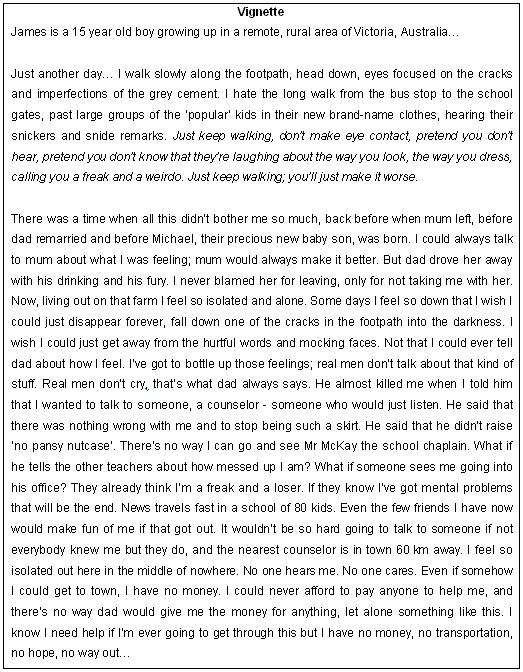full article:

Figure 1: Vignette. Although entirely fictitious, this case vignette was informed by the experiences of the second author (DA) who grew up in a rural area of Western Victoria, Australia.
The perspective presented in this case vignette is that of a teenage boy growing up in a rural Australian community (Fig 1). Perhaps James' difficulties - depression and bullying - are not unique to rural adolescents; however, the experience of these types of problems occurs in a very different context for a rural adolescent, compared with the ways in which they might be experienced by an adolescent living in an urban environment. The issues raised by the vignette will be the focus of this article. The issues to be considered by the review are: the nature of mental health issues for rural adolescents living in Australia; the characteristics of rural communities; barriers to seeking professional help; and difficulties that rural adolescents face in accessing appropriate mental health care.
Prevalence and nature of mental health issues for rural adolescents in Australia
There is some recognition by Australian researchers that, despite the lack of available data, it is probable that rates of psychiatric disorder are higher in rural populations1. With respect to adolescents, data have for some years revealed that Australia has one of the highest suicide rates in the world, particularly among rural adolescent males2. Recent data have revealed that the death rate due to suicide for males aged 15-24 years tends to rise with increasing remoteness, such that the suicide rate for remote areas (43 per 100 000) is twice as high as in capital cities (24 per 100 000)3.
With regard to other mental health problems, rural adolescents are thought to experience more difficulties with stress and coping when compared with urban adolescents4. Although rates of depression have been assumed to be higher among rural adolescents, this has not been systematically studied in Australia using an urban comparison sample. Notably, the largest survey on the mental health of young Australians (ie, the National Survey of Mental Health and Well-Being - Child and Adolescent Component5) compared metropolitan with non-metropolitan rates while acknowledging that this did not necessarily provide rates for 'rural' Australians (p.62). Therefore, research to establish the prevalence of mental health problems in adolescents who live in rural Australia, with reference to urban populations, is still needed.
Despite the paucity of empirical literature on rural adolescent mental health in Australia, we do have a reasonable understanding of the nature of mental health concerns of young Australians. A joint report by the Youth Affairs Council of Victoria and the Centre for Adolescent Health in Melbourne, Australia, discussed the results of a series of consultations with young people and workers with young people in rural and regional Victoria regarding the health and welfare issues facing rural Australian youth6. In terms of mental health issues, the young people consulted over the course of this project raised depression, youth suicide and anxiety as being of most concern. Factors thought to contribute to mental health problems among young people in rural Australia included higher unemployment, lack of opportunities for social interaction, and ostracism by the community for rebelling against social norms. Factors contributing to better mental health in rural settings were also identified in the report, and these included: community connectedness, belonging, and connection to the physical environment.
Characteristics of rural communities
Regardless of whether rates of disorder are higher among rural adolescents, there are characteristics of rural communities that are thought to present a range of unique challenges to young people with mental health issues. Recent research into the characteristics of rural communities and how they impact on people with mental illness is multidisciplinary; the most notable contribution is that of social geographer, Hester Parr7,8.
Parr and Philo7 distinguished between 'urban' and 'rural' environments in terms of physical and social proximity. Specifically, they referred to rural communities as places where people are physically distant but socially proximate, in direct contrast to people who live in urban areas. The impact of this 'rural paradox of proximity and distance' is the silencing of mental health difficulties and the exclusion of people with mental illness in a way that is more acute than in 'urban' areas. These may include low-level expressions of support and inclusion, lack of confidentiality and anonymity, and social discrimination or stigma8.
Based on interviews conducted with over 100 users of psychiatric care in the Scottish Highlands, Parr and Philo7 also argued that a stoic culture is characteristic of rural places. People with emotional and psychological problems are expected to 'soldier-on' without discussing their problems with family or neighbours. They discovered via interview that formal mental health services were the least preferred option for people with mental illness because of feared social stigma, and that collective caring practices or community intervention were rare. Nevertheless, it was also argued by Parr and colleagues that the gossiping that occurs in small rural communities has the potential to act as an 'informal safety net' in a way that might supplement mental health-care provision. This possibly works by early warning signs of relapse being detected by community members, and people with mental health problems being urged to seek help.
These issues have not been explored to the same extent in the Australian context, although the need for this research has been articulated by the nation's leading researchers9. One Australian study investigating this issue asked key stakeholders in rural mental health (eg, general medical practitioners, nurses, social workers, and rural counselors) to identify attitudes towards mental health problems that exist in rural Australian communities. The 22 informants identified the following: a reluctance to acknowledge mental health problems, social stigma, a culture of self-reliance, and a view that equates mental illness with 'insanity' as the main factors influencing help-seeking behaviour of people in rural and remote Australian communities10. Stoicism is a trait that has been associated with rural people for some time, particularly males. In general, stoic attitudes may make it more likely for rural people to deny mental health problems or postpone seeking medical or associated services until it is economically or socially convenient11. Furthermore, as the concept of wellbeing in rural Australia emphasizes the importance of productivity; there may be social advantages for young males in remaining stoic and emotionally inexpressive12.
In summary, while recent research (particularly the studies conducted from a social-geographic perspective) have greatly improved our understanding of mental health issues within the context of rural places, various questions remain unanswered. Key explanatory features of the processes of inclusion and exclusion in rural communities are yet to be identified, and researchers have argued that new research should go beyond the collection of empirical data to 'theorize care in rural geographies'8. Further research to identify processes in people-place interactions, with respect to rural mental health issues, will extend our theoretical understanding of these phenomena.
Barriers to seeking help for rural adolescents with mental health problems
Young people's attitudes to seeking professional help for mental health problems have received some attention in the literature both in Australia and overseas. Research in general has revealed that adolescents, regardless of place of residence, are greatly concerned with issues of confidentiality and anonymity, even when accessing primary care13. For instance, an Australian study by Booth and colleagues14 investigated barriers to accessing health care in high school students and non-school based adolescents utilizing focus groups. Confidentiality was perceived as a major barrier, with young people expressing concern that service providers may disclose personal information or that others would see them visiting a health-care provider. Another barrier to seeking help was a lack of knowledge of available health services, as well as costs and waiting lists associated with known health services. A barrier specific to female rural adolescents was the lack of female GPs in rural towns. Female rural youth indicated a preference to see female GPs but a limited number of GPs in rural areas often means that few young or female GPs are available, or that waiting lists are long.
Quine and colleagues15 examined the same data as Booth et al. for barriers to service use specific to rural areas of Australia. Confidentiality was identified as more of a concern in rural communities. Also, a lack of GPs and no 'bulk billing' (ie, government subsidized fee) were barriers to health service use specific to rural Australian communities. Long waiting lists to visit GPs, a limited choice of health-care providers, and transport difficulties were also identified as barriers to seeking health care for rural adolescents in Australia.
A study by Atkinson and colleagues16 investigated rural adolescents' perceived barriers to seeking help for primary health-care concerns. Participants consisted of 177 secondary school students, with 45% males, in years 7 to 12 from a small rural town in Victoria, Australia. A survey assessing aspects of accessing health care, including barriers to seeking help from health care providers, was administered to participants. Results reflected a range of barriers to rural adolescents utilizing health services. Concerns about anonymity were expressed by 71% of participants. Difficulties with transport and distances to service providers were selected by 64% and 39%, respectively. A lack of knowledge of health services other than GPs was a barrier to utilizing health services for 74% of participants. Other barriers to service use selected related to costs of health care, a lack of choice of service providers for young people, and embarrassment associated with parental involvement.
Regrettably, there is a lack of research in Australia on the way in which fear of social stigma acts as a barrier to adolescents seeking help in a rural setting. The only study related to this issue investigated the association between perceived stigma and help-seeking attitudes in a sample of adult participants from a rural town in Victoria, Australia17. The researchers used a cluster-sampling approach to recruit participants (ie, participants in randomly selected streets within a 30 km radius from the community mental health service were asked to complete surveys). The key finding from this study was that there was a significant association between high levels of perceived stigma and willingness to seek help from a GP for a mental health problem. Furthermore, there was a relationship between perceived 'weakness of character' and negative help-seeking attitudes for certain mental health problems, that is, attributions related to the character of the person with the mental illness were associated with negative help-seeking attitudes whereas biological explanations were associated with more positive attitudes.
In summary, it is presently unclear whether the stigma of mental illness is more prevalent in rural communities than urban communities, or if the experience of stigma is more profound in rural settings as a consequence of social proximity. Researchers now believe that stigma of mental illness is not necessarily a function of lack of knowledge of the symptoms or causes of mental disorder18. As it has been argued that one of the functions of social stigma is to create social distance19, it is possible that the universal phenomenon of public stigma is more intense in socially proximate settings. Exploratory research into the nature of public stigma in rural Australia will assist researchers to gain insight into this social phenomenon which can severely affect the lives of rural adolescents who experience mental health problems. Research is also needed to establish the role that fear of social stigma may play in preventing adolescents with mental health problems from seeking professional help. Furthermore, research concerning the influence of social stigma on the experience of mental illness for rural adolescents receiving community-based treatment would also shed light on this issue.
Access to appropriate mental health services for young people in Australia
Due to the lack of health professionals in rural areas with specialist mental health training, there have been attempts in Australia to up-skill practitioners in the primary care sector to deliver mental health care. There is no consensus on the fruitfulness of this approach in terms of consumer satisfaction or improved patient outcomes. One study conducted in Australia found that despite the increased need for GPs in rural areas to provide mental health care, they actually provided less mental health care when compared with urban GPs, prescribed less psychotropic medication, and recorded a lower percentage of consultations for psychological problems than their urban counterparts20. With respect to child and adolescent mental health services, it is not known how successful the delivery of these services in primary care might be when a family systems approach to the treatment of adolescents still living at home is considered good clinical practice21.
Cost and availability of transportation is a significant issue encountered by young people attempting to access specialist mental health services. Young people who are not licensed to drive or who do not own a car are often required to travel to regional centres to obtain professional help, and at the same time the availability of public transport in rural areas is poor or non-existent22. Various attempts at alternative models of mental health service delivery to overcome the barrier of distance have been pursued in Australia with limited success23, these include: satellite services (larger mental health services emanating from a regionally located 'hub'); mobile/visiting services (clinicians travel to more remote areas to provide services); and telepsychiatry (use of communication technology: eg, videoconferencing via ISDN to provide specialist consultations).
The delivery of mental health services via telepsychiatry to young people in particular has been found to be a viable alternative to face-to-face contact. Dossetor and colleagues21, for example, found that clients were generally satisfied with this form of service delivery, especially because it enabled access to expertise without the costs of travel. However, this area would still benefit from further research into the acceptability of alternative modes of service delivery for young people. Another potential avenue of research is the impact of the co-location of child and adolescent mental health services with adult psychiatric services, which still occurs in some rural towns in Australia (eg, Horsham, Victoria).
Concluding summary
The case vignette presented at the beginning of this article attempted to illustrate the difficulties facing adolescents with mental health problems in rural Australia. The subsequent review of the extant literature, focusing on the issues raised by this vignette, reinforced the strong need for exploratory research into rural adolescent mental health in general, particularly in order to establish the prevalence of mental health issues among young rural Australians.
Research conducted overseas suggests that characteristics of rural communities - that is, politics of exclusion and inclusion, social visibility, and stoic attitudes - are likely to create unique barriers for adolescents with mental health problems who require professional help; however, these processes as applied to the Australian context are not well understood. In addition to the barriers that may arise from the culture of rural communities - for example, the lack of confidentiality and anonymity, social stigma of mental illness - the poor availability of local services and distance from specialist services are likely to set up further barriers for rural Australian adolescents. Alternative means of service delivery to rural adolescents have been examined, but this line of inquiry is still in its infancy and it has not been established whether services in this form are generally effective for, or acceptable to, young Australians.
A future focus for research
There are real challenges to early intervention for adolescent mental health problems in rural communities where there are such significant barriers to accessing care. Some of these barriers appear to result from the social-cultural factors (eg, stigma of mental illness; social politics of exclusion and inclusion) while others are purely logistic (eg, difficulties in transportation across vast geographical distances). Still others are an inevitable consequence of living in a small community - for example, concerns about lack of anonymity and gossip. When combined, these factors make it highly unlikely that an adolescent growing up in a rural area will seek help for a mental health problem in its early stages. Treatment outcome studies across a range of mental health problems suggest that the size of the interval between the onset of disorder and receiving effective intervention is indicator of poor prognosis24-26. If the burden of care associated with mental health problems in Australian youth is to be reduced, then strategies aimed at reducing the interval between the onset of mental health problems and seeking help for those problems are needed. The delivery of services to adolescents in rural areas must first address the concerns these adolescents have regarding their anonymity. Consideration should also be given to the location of services and the acceptability of alternative means of service delivery. First and foremost, however, adolescents need to feel secure in asking for help for their problems early, without fear of social stigma.
Addressing the social stigma surrounding mental illness is an enormous challenge. Recent attempts in Australia include the Sane Australia's StigmaWatch Campaign, which allows members of the public to report instances of stigma in the community, as well as the National Media and Mental Health Group which provide guidelines to media outlets on how to report about mental illness in a way that minimizes public stigma27. However, as yet no single campaign targeted at rural communities has been launched. Furthermore, the focus of Australian campaigns has been on increasing knowledge of mental illness and minimizing negative portrayals of people with mental illness in the media; however, studies that have formed the basis for anti-stigma campaigns overseas have revealed that social stigma is not necessarily related to lack of understanding of mental illness but is, rather, a form of active discrimination18. With respect to rural communities, we do not currently understand the phenomenology of social stigma for rural people and, therefore, further research in this area is warranted.
What is also apparent from the review is that the research in Australia to date has not sought the perspective of rural adolescents who suffer from mental illness. Research has either sought the opinions of mental health workers10 or the opinions of high school students13-16. There is a notable lack of research on the mental health of young Australians that includes adolescents with mental illness as participants and, therefore, these young people who have direct experience of rural adolescent mental health issues do not have a 'voice'. Exploratory research that involves rural adolescents as participants is the next step in gaining a better understanding of the issues that these young people face in accessing help for their mental health problems.
Beyond the need for exploratory research to address the lack of an evidence-base for rural adolescent mental health in Australia, future research also needs to focus on ways to overcome the barriers the young people in rural Australia face in accessing mental health services. These efforts could broadly focus on: (i) raising public awareness; (ii) funded interventions at a school level; and (iii) improvements to health-system delivery.
In conclusion, there is a lack of literature in the area of rural adolescent mental health in Australia. Based on existing knowledge, however, the rural Australian context is likely to produce the type of scenario represented by the vignette presented at the beginning of this article - an adolescent with mental health problems in rural Australia is socially isolated, reluctant to seek social support because of fear of stigmatizing attitudes, is prevented from accessing professional help because of social, financial, and geographical barriers, and, as a result of all these factors, experiences a profound sense of hopelessness. A future focus for research efforts in this area is the identification of unique rural barriers to seeking help for mental health problems, and strategies to overcome these barriers, so that young people with mental health issues are more likely to access appropriate care.
References
1. Fraser C, Judd F, Jackson H, Murray G, Humphreys J, Hodgins G. Does one size really fit all? Why the mental health of rural Australians requires further research. Australian Journal of Rural Health 2002; 10: 288-295.
2. Bourke L. Toward understanding youth suicide in an Australian rural community. Social Science and Medicine 2003; 57: 2355-2365.
3. Moon L, Meyer P, Grau J. Australia's young people: Their health and wellbeing 1999. Canberra: Australian Institute for Health and Welfare, 1999.
4. Burns JJ, Cottrell L, Perkins K et al. Depressive symptoms and health risk among rural adolescents. Pediatrics 2004; 113: 1313-1320.
5. Sawyer M, Arney FM, Baghurst PA. The mental health of young people in Australia. Canberra: Mental Health and Special Programs Branch, Commonwealth Department of Health and Aged Care, 2000.
6. Centre for Adolescent Health & Youth Affairs Council of Victoria: Rural life of us. (Online) 2002. Available: http://www.yacvic.org.au/includes/pdfs_wordfiles/ruralreport.pdf (Accessed 22 February 2006).
7. Parr H, Philo C. Rural mental health and social geographies of caring. Social and Cultural Geography 2003; 4: 471-488.
8. Parr H, Philo C, Burns N. Social geographies of rural mental health: Experiencing inclusions and exclusions. Transactions of the Institute of British Geographers 2004; 29: 401-419.
9. Judd F, Murray G, Fraser C, Humphreys J, Hodgins G, Jackson H. The mental health of rural Australians: developing a framework for strategic research. Australian Journal of Rural Health 2002; 10: 296-301.
10. Fuller J, Edwards J, Procter N, Moss J. How definition of mental health problems can influence help seeking in rural and remote communities. Australian Journal of Rural Health 2000; 8: 148-153.
11. Elliott-Schmidt R, Strong J. The concept of well-being in a rural setting: understanding health and illness. Australian Journal of Rural Health 1997; 5: 59-63.
12. Courtney W. A global perspective on the field of men's health: An editorial. International Journal of Men's Health 2002; 1: 1-13.
13. Elliott BA, Larson JT. Adolescents in mid-sized and rural communities: Foregone care, perceived barriers, and risk factors. Journal of Adolescent Health 2004; 35: 303-309.
14. Booth ML, Bernard D, Quine S et al. Access to health care among Australian adolescents: Young people's perspectives and their sociodemographic distribution. Journal of Adolescent Health 2004; 34: 97-103.
15. Quine S, Bernard D, Booth M et al. Health and access issues among Australian adolescents: A rural-urban comparison. Rural and Remote Health 3: 245. (Online) 2003. Available: http://rrh@deakin.edu.au (Accessed 22 February 2006).
16. Atkinson K, Schattner P, Margolis S. Rural secondary school students living in a small community: Their attitudes, beliefs and perceptions towards general practice. Australian Journal of Rural Health 2003; 11: 73-80.
17. Wrigley S, Jackson H, Judd F, Komiti A. Role of stigma and attitudes toward help-seeking from a general practitioner for mental health problems in a rural town. Australian and New Zealand Journal of Psychiatry 2005; 39: 514-521.
18. Crisp AH, Gelder MG, Rix S, Meltzer HI, Rowlands, OJ. Stigmatisation of people with mental illness. British Journal of Psychiatry 2000; 177: 4-7.
19. Dietrich S, Beck M, Bujantugs B, Kenzine D, Matschinger H, Angermeyer MC. The relationship between public causal beliefs and social distance toward mentally ill people. Australian and New Zealand Journal of Psychiatry 2004; 38: 348-357.
20. Caldwell TM, Jorm AF, Knox S, Braddock D, Dear KBG, Britt H. General practice encounters for psychological problems in rural, remote and metropolitan areas in Australia. Australian and New Zealand Journal of Psychiatry 2004; 38: 774-780.
21. Dosseter DR, Nunn KP, Fairley M, Eggleton D. A child and adolescent psychiatric outreach service for rural New South Wales: A telemedicine pilot study. Journal of Paediatrics and Child Health 1999; 35: 525-529.
22. Green R, McDonald J. Transport for young people in a rural area. Youth Studies Australia 1996; 15: 38-43.
23. Judd F, Fraser C, Grigg M et al. Rural psychiatry: Special issues and models of service delivery. Disease Management and Health Outcomes 2002; 10: 771-781.
24. Conus P, McGorry PD. First-episode mania: A neglected priority for early intervention. Australia and New Zealand Journal of Psychiatry 2002; 36: 158-172.
25. Steinhausen HC, Rauss-Mason C, Serdel R. Follow up studies of anorexia nervosa: A review of four decades of outcome research. Psychological Medicine 1991; 21: 447-451.
26. Stephensen J. Delay in treating schizophrenia may narrow therapeutic window of opportunity. Journal of the American Medical Association 2000; 282: 2091-2092.
27. Sane Australia. Stigma watch. (Online 2005). Available: http://www.sane.org/index.php?option=displaypage&Itemid=266&op=page (accessed 22 February 2006).





